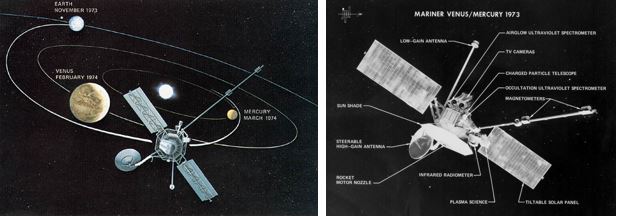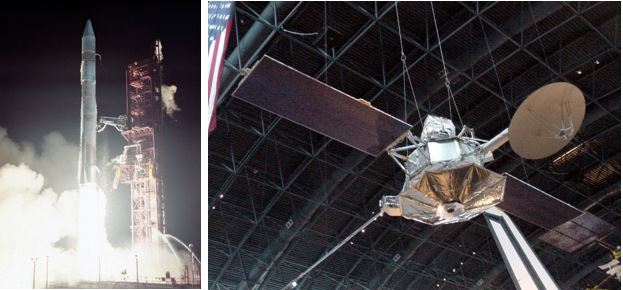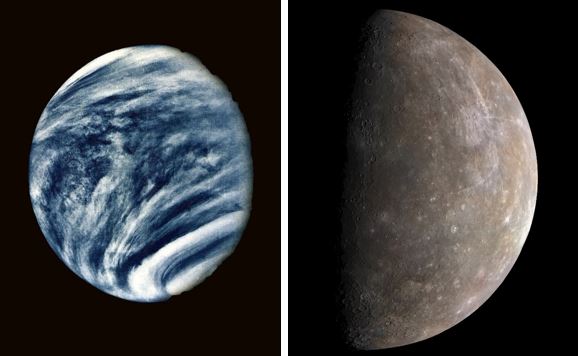A unique opportunity presented itself in 1973 to send a spacecraft to visit both Venus and Mercury in a single mission. Using gravity assist, a technique theorized for decades but never used before, under favorable conditions a spacecraft sent to one planet can use that planet’s gravitational force to essentially slingshot on to its next target. The method saved the cost of additional fuel and a larger rocket that would be necessary to launch the heavier spacecraft as well as time to get to the ultimate destination. In 1969, NASA approved a plan to send a spacecraft to Mercury, using Venus for a gravity assist. The mission, first known as Mariner Venus Mercury, was later renamed Mariner 10 and managed by the Jet Propulsion Laboratory in Pasadena, California. It was the last in the Mariner series of very successful spacecraft that revealed many secrets about the inner solar system.
Planetary scientists had learned a great deal about Venus from both Earth-based observations and spacecraft encounters. Two American spacecraft, Mariner 2 in 1962 and Mariner 5 in 1967, studied Venus during their fly-bys and revealed much about the planet’s atmosphere, showing it to be much hotter (527o C) and denser (75-100 atmospheres) than previously expected, and found only a very weak magnetic field. The Soviet Union dispatched several spacecraft to Venus as part of the Venera program and two, Venera 7 in 1970 and Venera 8 in 1972, managed to soft-land on the planet’s hellish surface and return data for less than an hour. Their scientific instruments confirmed the high temperatures and pressures, to which the spacecraft rapidly succumbed.
In comparison, very little was known about Mercury, the innermost planet in the solar system. No spacecraft had ever visited the planet, and its small size, distance from Earth, and proximity to the Sun made terrestrial observations difficult. A direct flight to Mercury would require a large expensive rocket due to the extra fuel required to reach the planet. The gravity-assist technique provided an opportunity for the first spacecraft-based observations of the little-known world.
Mariner 10’s goals at Venus were to add to existing information, such as closeup photography revealing the structure of the upper atmosphere, while at Mercury it was to conduct a more global survey of the planet. To accomplish these goals, Mariner 10 carried six scientific instruments – the Television Photography System consisting of two telescopes to image the planets; an infrared radiometer to calculate the temperature of Venus’ atmosphere and Mercury’s surface; an ultraviolet spectrometer primarily to detect any atmosphere around Mercury; plasma detectors to study the solar wind inside the orbit of Venus for the first time; a charged particle telescope to study cosmic radiation; and magnetometers to detect any magnetic field around Mercury. In addition, as the spacecraft passed behind the planet, its radio signals were used to probe Mercury’s atmosphere and precisely measure its radius. By precisely tracking the spacecraft’s trajectory as it passed Mercury, its mass and gravitational characteristics could be determined.
Shortly after midnight on November 3, 1973, the 500-kg Mariner 10 lifted off aboard its Atlas-Centaur rocket from Launch Pad 36B at Cape Canaveral, Florida. After a short time in a parking orbit around the Earth, the Centaur stage reignited, sending Mariner 10 toward Venus. During its first week in space, the spacecraft calibrated its camera system by taking photographs of the Earth and Moon, including of the Moon’s north polar region that was poorly imaged by earlier spacecraft. The three-month cruise to Venus included several spacecraft malfunctions, overcome by the dedicated ground control team. In January 1974, Mariner 10 made ultraviolet observations of Comet Kohoutek, adding to observations by ground-based observatories as well as the astronauts aboard the Skylab space station in Earth orbit.
The spacecraft passed within 5,768 kilometers (km) of Venus on February 5, 1974. During the fly-by, Mariner 10 sent back information about the Venus’ atmosphere and beaming back the first close-up images of the cloud-shrouded planet. Photographs taken in visible light revealed a featureless planet, but cloud detail was readily visible using ultraviolet filters. Mariner 10 returned 4,165 pictures of Venus. The gravity assist was successful, placing the spacecraft on a trajectory toward Mercury which it encountered on March 29 at a distance of 703 km. During this first spacecraft fly-by of the innermost planet, Mariner 10’s more than 2,000 photographs revealed Mercury’s surface to be heavily-cratered, reminiscent of the Moon. The spacecraft’s other instruments detected a weak magnetic field and a very thin atmosphere composed primarily of helium. Italian scientist and mathematician Giuseppe Colombo (1920-1984) from the University of Padua calculated that Mariner 10’s trajectory would make it possible to revisit Mercury every six months, with the spacecraft making one revolution around the Sun and Mercury making two during the interim. On September 21, during its second fly-by of Mercury, Mariner 10 passed at a more distant range of 48,069 km from the small planet’s southern hemisphere. The spacecraft returned 500 more images of Mercury. And on March 16, 1975, Mariner 10, nearly out of attitude control gas, made its final visit to Mercury, this time at a close range of 327 km, passing over the planet’s north pole. The spacecraft returned some of the most detailed images and additional data on the planet’s magnetic field. Just eight days after this last encounter, Mariner 10 exhausted its supply of attitude control gas and ground controllers turned off its transmitter. The silent spacecraft sailed on in solar orbit.
The mission of Mariner 10 was a great success and unique in many ways. It was the first spacecraft to use gravity assist to visit more than one planet, a technique now used regularly to visit multiple bodies in the solar system. It was the first spacecraft to take close-up photographs of Venus and the first to explore Mercury. In just over 500 days, on a journey of more than a billion kilometers, Mariner 10 visited Venus once and Mercury three times, returning 7,000 photographs and greatly expanding our understanding of both planets. It also photographed the Earth and Moon and studied Comet Kohoutek.
After Mariner 10, many spacecraft returned to explore Venus. Some flew by the planet, others entered orbit, while still others dropped off probes, balloons, and soft landers to thoroughly study the planet and its atmosphere. No spacecraft would visit Mercury again for 36 years, until NASA’s MESSENGER spacecraft arrived to study the planet from orbit between 2011 and 2015. The joint European-Japanese BepiColombo spacecraft, named after the same Giuseppe Colombo who calculated Mariner 10’s resonant trajectory, is currently on its way to Mercury. Composed of two separate spacecraft, it will spend one year in orbit around Mercury after arriving in 2025.

























